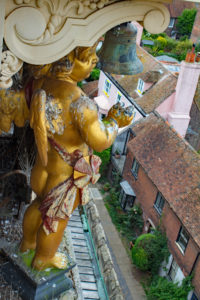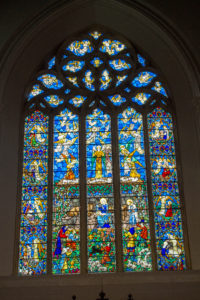In “St Mary’s Church”:https://www.ryeparishchurch.org.uk/6613c646.htm, Rye, a donation of £4 and a gift aid signature allowed us to climb 82 steps up the tower and negotiate a 16” wide passage, before heading out onto the viewing platform, described as the best in town. The first section was a wooden staircase, and the passage wasn’t as narrow as I’d feared, and I emerged at the end without getting stuck. Having reached the bell ringing platform there were three wooden ladders to negotiate before a small door led out onto the terrace. Signs constantly reminded us that “while the churchwardens have taken all reasonable precautions certain parts of the Tower Battlements are dangerous to young children and careless persons”. I tried not to be careless.
Walking around the four sides of the square shaped tower provided panoramic views of both the river and town. We spied a rather grand looking building, and both wondered what it was. It wasn’t until we left the following day, we realised it was Rye railway station.
The church clock is the oldest working church clock in the country, and our position also gave us a closeup view of the four golden quarterboys (named because they strike the quarter hours).
Once safely down, we took in the church and stained-glass windows. There was a small shop beneath a rather dark and drab window with a sign saying they preferred contactless as there were no banks in Rye: a sad sign of the times bearing in mind the number of visitors and tradespeople.
The magnificent Rye Millennium Embroidery, created by the Rye Branch of the Embroiders Guild, was prominently displayed. A sign told us it did not need cleaning as the fabric had been deliberately stained to resemble the old town wall in Cinque Port Street. The various individual panels depicted Rye scenes past and present.









